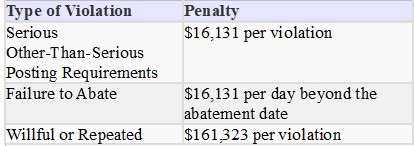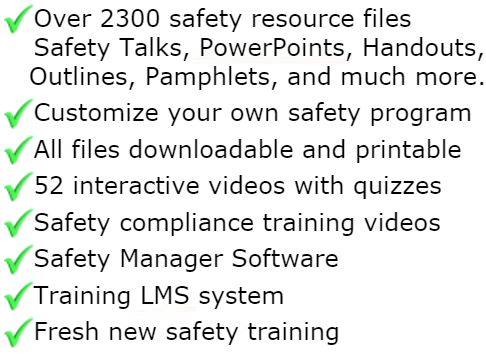
Training Program Guidelines
Using this training program development model, employers or supervisors can develop and administer safety and health training programs that address problems specific to their own business, fulfill the learning needs of their own employees, and strengthen the overall safety and health program of the workplace.
Step 1: Determining If Training Is Needed
The first step in the training process is a basic one: to determine whether a problem can be solved by training. Whenever employees are not performing their jobs properly, it is often assumed that training will bring them up to standard. However, it is possible that other actions (such as hazard abatement or the implementation of engineering controls) would enable employees to perform their jobs properly.
Ideally, safety and health training should be provided before problems or accidents occur. This training would cover both general safety and health rules and work procedures, and would be repeated if an accident or near–miss incident occurred.
Problems that can be addressed effectively by training include those that arise from lack of knowledge of a work process, unfamiliarity with equipment, or incorrect execution of a task. Training is less effective (but still can be used) for problems arising from an employee's lack of motivation or lack of attention to the job. Whatever its purpose, training is most effective when designed in relation to the goals of the employer's total safety and health program.
If the problem is one that can be solved, in whole or in part, by training, then the next step is to determine what training is needed. For this, it is necessary to identify what the employee is expected to do and in what ways, if any, the employee's performance is deficient. This information can be obtained by conducting a job analysis which pinpoints what an employee needs to know in order to perform a job.
When designing a new training program, or preparing to instruct an employee in an unfamiliar procedure or system, a job analysis can be developed by examining engineering data on new equipment or the safety data sheets on unfamiliar substances. The content of the specific Federal or State OSHA standards applicable to a business can also provide direction in developing training content. Another option is to conduct a Job Hazard Analysis. This is a procedure for studying and recording each step of a job, identifying existing or
potential hazards, and determining the best way to perform the job in order to reduce or eliminate the risks. Information obtained from a Job Hazard Analysis can be used as the content for the training activity.
If an employee's learning needs can be met by revising an existing training program rather than developing a new one, or if the employee already has some knowledge of the process or system to be used, appropriate training content can be developed through such means as:
1. Using company accident and injury records to identify how accidents occur and what can be done to prevent them from recurring.
2. Requesting employees to provide, in writing and in their own words, descriptions of their jobs. These should include the tasks performed and the tools, materials and equipment used.
3. Observing employees at the worksite as they perform tasks, asking about the work, and recording their answers.
4. Examining similar training programs offered by other companies in the same industry, or obtaining suggestions from such organizations as the National Safety Council (which can provide information on Job Hazard Analysis), the Bureau of Labor Statistics, OSHA–approved State programs, OSHA full–service Area Offices, OSHA–funded State consultation programs, or the OSHA Office of
Training and Education.
The employees themselves can provide valuable information on the training they need. Safety and health hazards can be identified through the employees' responses to such questions as whether anything about their jobs frightens them, if they have had any near–miss incidents, if they feel they are taking risks, or if they believe that their jobs involve hazardous operations or substances. Once the kind of training that is needed has been determined, it is equally important to determine what kind of training is not needed. Employees should be made aware of all the steps involved in a task or procedure, but training should focus on those steps on which improved performance is needed. This avoids unnecessary training and tailors the training to meet the needs of the employees.
Step 2 - Identifying Goals And Objectives
Once the employees' training needs have been identified, employers can then prepare objectives for the training. Instructional objectives, if clearly stated, will tell employers what they want their employees to do, to do better, or to stop doing.
Learning objectives do not necessarily have to be written, but in order for the training to be as successful as possible, clear and measurable objectives should be thought–out before the training begins. For an objective to be effective it should identify as precisely as possible what the individuals will do to demonstrate that they have learned, or that the objective has been reached. They should also describe the important conditions under which the individual will demonstrate competence and define what constitutes acceptable performance.
Using specific, action–oriented language, the instructional objectives should describe the preferred practice or skill and its observable behavior. For example, rather than using the statement: "The employee will understand how to use a respirator" as an instructional objective, it would be better to say: "The employee will be able to describe how a respirator works and when it should be used." Objectives are most effective when worded in sufficient detail that other qualified persons can recognize when the desired behavior is exhibited.
Developing Learning Activities
Once employers have stated precisely what the objectives for the training program are, then learning activities can be identified and described. Learning activities enable employees to demonstrate that they have acquired the desired skills and knowledge. To ensure that employees transfer the skills or knowledge from the learning activity to the job, the learning situation should simulate the actual job as closely as possible.
Thus, employers may want to arrange the objectives and activities in a sequence which corresponds to the order in which the tasks are to be performed on the job, if a specific process is to be learned. For instance, if an employee must learn the beginning processes of using a machine, the sequence might be:
(1) to check that the power source is connected;
(2) to ensure that the safety devices are in place and are operative;
(3) to know when and how to throw the switch; and so on.
A few factors will help to determine the type of learning activity to be incorporated into the training. One aspect is the training resources available to the employer. Can a group training program that uses an outside trainer and film be organized, or should the employer personally train the employees on a one–to–one basis? Another factor is the kind of skills or knowledge to be learned. Is the learning oriented toward physical skills (such as the use of special tools) or toward mental processes and attitudes? Such factors will influence the type of learning activity designed by employers. The training activity can be group–oriented, with lectures, role play, and demonstration; or designed for the individual as with self–paced instruction.
The determination of methods and materials for the learning activity can be as varied as the employer's imagination and available resources will allow. The employer may want to use charts, diagrams, manuals, slides, films, viewgraphs (overhead transparencies), videotapes, audiotapes, or simply blackboard and chalk, or any combination of these and other instructional aids. Whatever the method of instruction, the learning activities should be developed in such a way that the employees can clearly demonstrate that they have acquired the desired skills or knowledge.
Conducting The Training
With the completion of the steps outlined above, the employer is ready to begin conducting the training. To the extent possible, the training should be presented so that its organization and meaning are clear to the employees. To do so, employers or supervisors should:
(1) provide overviews of the material to be learned;
(2) relate, wherever possible, the new information or skills to the employees' goals, interests, or experience; and
(3) reinforce what the employees learned by summarizing the program's objectives and the key points of information covered.
These steps will assist employers in presenting the training in a clear, unambiguous manner.
In addition to organizing the content, employers must also develop the structure and format of the training. The content developed for the program, the nature of the workplace or other training site, and the resources available for training will help employers determine for themselves the frequency of training activities, the length of the sessions, the instructional techniques, and the individuals best qualified to present the information.
In order to be motivated to pay attention and learn the material that the employer or supervisor is presenting, employees must be convinced of the importance and relevance of the material. Among the ways of developing motivation are:
(1) explaining the goals and objectives of instruction;
(2) relating the training to the interests, skills, and experiences of the employees;
(3) outlining the main points to be presented during the training session; and
(4) pointing out the benefits of training (e.g., the employee will be better informed, more skilled, and thus more valuable both on the job and on the labor market; or the employee will, if he or she applies the skills and knowledge learned, be able to work at reduced risk). An effective training program allows employees to participate in the training process and to practice their skills or knowledge. This will help to ensure that they are learning the required knowledge or skills and permit correction if necessary. Employees can become involved in the training process by participating in discussions, asking questions, contributing their knowledge and expertise, learning through hands–on experiences, and through role–playing exercises.
Step 3 - Evaluation
To make sure that the training program is accomplishing its goals, an evaluation of the training can be valuable. Training should have, as one of its critical components, a method of measuring the effectiveness of the training. A plan for evaluating the training sessions, whether written or thought–out by the employer, should be developed when the course objectives and content are developed. It should not be delayed until the training has been completed. Evaluation will help employers or supervisors determine the amount of learning achieved and whether an employee's performance has improved on the job. Among the methods of evaluating training are:
(1) Student opinion. Questionnaires or informal discussions with employees can help employers determine the relevance and appropriateness of the training program;
(2) Supervisors' observations. Supervisors are in good positions to observe an employee's performance both before and after the training and note improvements or changes; and
(3) Workplace improvements. The ultimate success of a training program may be changes throughout the workplace that result in reduced injury or accident rates.
However it is conducted, an evaluation of training can give employers the information necessary to decide whether or not the employees achieved the desired results, and whether the training session should be offered again at some future date.
Step 4 - Improving the Program
If, after evaluation, it is clear that the training did not give the employees the level of knowledge and skill that was expected, then it may be necessary to revise the training program or provide periodic retraining. At this point, asking questions of employees and of those who conducted the training may be of some help. Among the questions that could be asked are:
(1) Were parts of the content already known and, therefore, unnecessary?
(2) What material was confusing or distracting?
(3) Was anything missing from the program?
(4) What did the employees learn, and what did they fail to learn?
It may be necessary to repeat steps in the training process, that is, to return to the first steps and retrace one's way through the training process. As the program is evaluated, the employer should ask:
(1) If a job analysis was conducted, was it accurate?
(2) Was any critical feature of the job overlooked?
(3) Were the important gaps in knowledge and skill included?
(4) Was material already known by the employees intentionally omitted?
(5) Were the instructional objectives presented clearly and concretely?
(6) Did the objectives state the level of acceptable performance that was expected of employees?
(7) Did the learning activity simulate the actual job?
(8) Was the learning activity appropriate for the kinds of knowledge and skills required on the job?
(9) When the training was presented, was the organization of the material and its meaning made clear?
(10) Were the employees motivated to learn?
(11) Were the employees allowed to participate actively in the training process?
(12) Was the employer's evaluation of the program thorough?
A critical examination of the steps in the training process will help employers to determine where course revision is necessary.
Matching Training
While all employees are entitled to know as much as possible about the safety and health hazards to which they are exposed, and employers should attempt to provide all relevant information and instruction to all employees, the resources for such an effort frequently are not, or are not believed to be, available. Employers are often faced with the problem of deciding who is in the greatest need of information and instruction.
One way to differentiate between employees who have priority needs for training and those who do not is to identify employee populations which are at higher levels of risk. The nature of the work will provide an indication that such groups should receive priority for information on occupational safety and health risks.
Identifying Employees At Risk
One method of identifying employee populations at high levels of occupational risk (and thus in greater need of safety and health training) is to pinpoint hazardous occupations. Even within industries which are hazardous in general, there are some employees who operate at greater risk than others. In other cases the hazardousness of an occupation is influenced by the conditions under which it is performed, such as noise, heat or cold, or safety or health hazards in the surrounding area. In these situations, employees should be trained not only on how to perform their job safely but also on how to operate within a hazardous environment.
A second method of identifying employee populations at high levels of risk is to examine the incidence of accidents and injuries, both within the company and within the industry. If employees in certain occupational categories are experiencing higher accident and injury rates than other employees, training may be one way to reduce that rate. In addition, thorough accident investigation can identify not only specific employees who could benefit from training but also identify company–wide training needs.
Research has identified the following variables as being related to a disproportionate share of injuries and illnesses at the worksite on the part of employees:
The age of the employee (younger employees have higher incidence rates). The length of time on the job (new employees have higher incidence rates).
The size of the firm (in general terms, medium–size firms have higher incidence rates than smaller or larger firms).
The type of work performed (incidence and severity rates vary significantly by SIC Code). The use of hazardous substances (by SIC Code).
These variables should be considered when identifying employee groups for training in occupational safety and health.
Identifying Employees At Risk
Determining the content of training for employee populations at higher levels of risk is similar to determining what any employee needs to know, but more emphasis is placed on the requirements of the job and the possibility of injury. One useful tool for determining training content from job requirements is the Job Hazard Analysis. This procedure examines each step of a job, identifies existing or potential hazards, and determines the best way to perform the job in order to reduce or eliminate the hazards. Its key elements are:
(1) job description,
(2) job location,
(3) key steps (preferably in the order in which they are performed),
(4) tools, machines and materials used,
(5) actual and potential safety and health hazards associated with these key job steps, and
(6) safe and healthful practices, apparel, and equipment required for each job step. Material Safety Data Sheets (SDS) can also provide information for training employees in the safe use of materials. These data sheets, developed by chemical manufacturers and importers, are supplied with manufacturing or construction materials and describe the ingredients of a product, its hazards, protective equipment to be used, safe handling procedures, and emergency first–aid responses.
The information contained in these sheets can help employers identify employees in need of training (i.e., workers handling substances described in the sheets) and train employees in safe use of the substances. Material Safety Data Sheets are generally available from suppliers, manufacturers of the substance, large employers who use the substance on a regular basis, or they can be developed by employers or trade associations. SDS are particularly useful for those employers who are developing training on chemical use as required by OSHA's Hazard Communication Standard.

GET INSTANT ACCESS
to THE MEMBERS LIBRARY
Safety materials created by safety professionals.
Access to the Safety Manager software.
Wide variety of safety videos and courses.
**Brand New** Safety Training Management System
Pre-Made Safety Materials Ready For Use
Created by experienced safety professionals & risk consultants. Saving you time, money, and risk of injuries.
95% of the work already done.
Below are the maximum penalty amounts, with the annual adjustment for inflation, that may be assessed after Jan. 15, 2024. (See OSHA Memo, Jan. 8, 2024).

**New OSHA HEAT 90 DAY**
>>Download Free HERE<<
**New 2024 OSHA 300 Form**
>>Download Free HERE<<
**Brand New**
Free with full membership subscription
Training LMS System
Ask The Safety Consultant
Safety Equipment Deal Finder

“SafetyInfo.com is the first go-to website for safety professionals and companies to use in establishing a solid safety program"
-Mike McKenzie, Certified Safety & Health Manager (CSHM), McSafety Solutions™
Note: You must have a full subscription to the Safety Library in order to use this material. Any use outside of your organization, for resell, or without an active membership is strictly prohibited and may result in prosecution under copyright infringement laws. Please contact us first, if you would be interested in reselling or using our materials for reproduction.
Inside the Members Library
Topic Index
Accident Prevention
Air Quality
Asbestos
Bloodborne Pathogens
Boilers
Chemical Safety
Compressed Gas
Confined Space
Construction
Construction Worksite
Cranes & Slings
Driver / Fleet Safety
Drug Free Workplace
Electrical
Emergency Management
Engineering Safety
Environmental
Equipment
Ergonomics
Fall Protection
Fire Safety & Prevention
First Aid
Flammable Materials
Forklifts
Hazard Communication
Hazardous Materials
Hearing Protection
Heat Stress
Hot Work
Housekeeping
Job Safety Analysis
Laboratory
Ladders
Lead
Lockout-Tagout
Machinery & Equipment
Material Handling
MSDS (SDS)
Medical & First Aid
Occupational Health
Office Safety
Off the Job Safety
Personal Protection
Process Safety
Record Keeping
Respiratory Protection
Silica Safety
Rules & Policies
Signs & Labels
Slips, Trips & Fall
Training
Terrorism Programs
Tool Safety
Vehicle & Driver
Violence Programs
Welding & Hot Work
Training Videos
Library Index
Training Materials
Videos/Courses
Talks
Articles
PowerPoint
Handouts
Training Overheads
Quizzes
Supervisor Briefs
Management Briefs
Safety Sessions
2 Minute OSHA Safety Talks
Pamphlets
First Aid Training
Supervisor Training
Hazardous Materials
Bomb Threat
Crossword Puzzles
Biological Agents
Forms & Documents
Forms
Checklists
Audit Guides
Inspections Guides
Signs & Labels
Environmental Audit Guides
Recordkeeping - OSHA 300
Sign & Label Maker
Safety Management Resources
Safety Manuals/Written Programs
Ergonomic Programs
Emergency Plans
Process Safety Management
Construction Safety
Occupational Health
Environmental
Topic Sheets
DOT Fleet-Driver
Hazardous Materials
Chemical Safety
Drug Free Workplace
Terrorism Programs
Development Guides
Safety Manager Software
Safety References & Graphics
Technical Safety Information
Posters
Topic & Fact Sheets
Development Information
Job Specific Safety Rules
Terrorism
Calculators
Safety Comic Strips
New Safety Training System
Schedule and train your employees with our materials. Add unlimited amount of employees. Record all progress and issue certificates. For group and individual training sessions.

